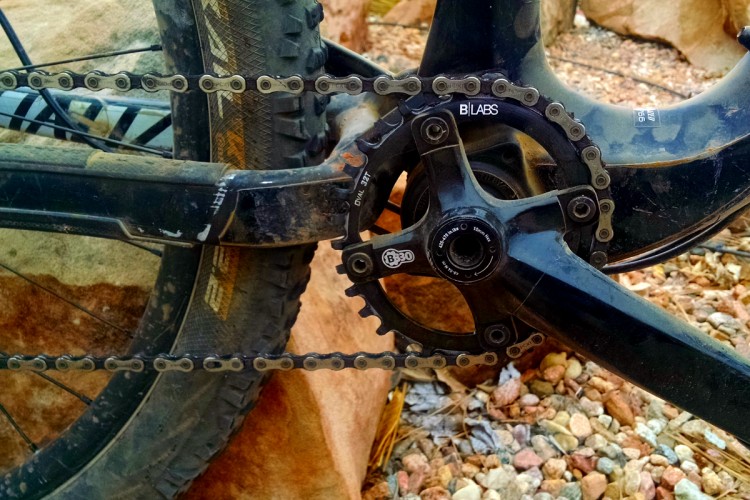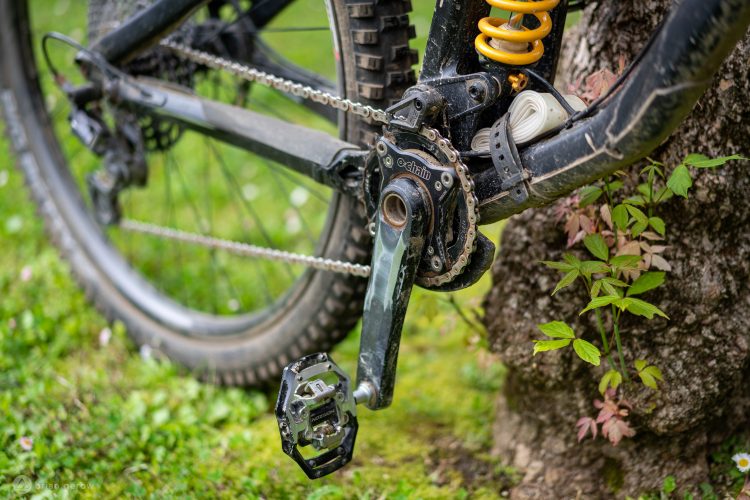Elliptical chainrings have been around for years and while not everyone agrees about their efficacy, they have shown staying power, albeit for a small subset of riders. ROTOR is a Spanish company that produces elliptical chainrings and cranksets along with traditional round rings. I spoke with Phillip Mark Lucas about the advantages to elliptical rings and how that translates to mountain bike applications. Here’s part of our conversation.
Phillip: The main reason to go ovalized is that the power your leg develops throughout the stroke is not constant. There are areas which are stronger, there are areas that are weaker. That’s why cyclists are so focused on having a good spin. They’re compensating for the apparent and obvious problem we have while pedaling.
So .. the Rotor concept is to vary the resistance in the drivetrain in line with what your legs can and cannot do. That gives you an engineering solution which is the perfect spin. Of course there’s still going to be variation but what it’s doing is it’s making the bike’s drivetrain work for your legs which gives you a smoother spin. Peer reviewed scientific studies show [a] 1.6 second time gain per kilometer in a time trial situation. That’s aerobic effort, that’s not even going into anaerobic.
One of the key features of the Q-ring beyond the fact that it simply makes the drivetrain more efficient for your legs is that it can be set up for every individual. Not everybody has the same pedaling stroke. Some people arrive at their maximum power later and some earlier due to a myriad of factors. We’ve got a very simple guide which helps you get used to going from a round ring to an oval ring and then to find your optimal set-up on the oval ring. The process depends on the cyclist but can one week or it could take 3 weeks.
Jeff: So what is that going to do on a full-suspension bike? Is that going to affect pedal bob? Is [a Q-Ring] going to reduce it?
Phillip: That’s a good question. Theoretically it’s going to reduce pedal bob because your maximum torque is slightly reduced and your minimum torque is slightly increased. Pedal bob is created by torque variations.
Now the chainring height variation, we’re only talking a fraction of an inch so it’s not going to have a great effect on your linkages however the torque variation, the reduction of that, it doesn’t just give you a more stable suspension, it also gives you better grip at the rear tire. You’re going to have less chance of the rear tire slipping out…
Jeff: Because you get even power.
Phillip: Exactly. Really technical, slow sections, momentum-eating rock sections, because the torque curve is much more in line with your legs’ capacity, you’ve got a much higher chance of getting through the technical section, cresting over hills that you can’t quite make, getting through sand bogs.
Jeff: What does that do for chain retention?
Phillip: It’s quite interesting–there is no effect. It’s the same as a round ring. The main problem in off-road situations is not the drivetrain it’s the terrain you’re riding over. The terrain you’re riding is throwing the chain all over the place.
The company’s 1x chainrings feature slightly more ovality than the multi-ring set-ups since they don’t need to be optimized for shifting. These 1x rings retail for around $135-150 depending on crankset compatibility. Full, multi-ring cranksets from ROTOR are priced between $350-600.
Some readers may compare ROTOR’s Q-Rings to the Shimano Biopace system from years ago but the rings in the ROTOR system are actually flipped 90-degrees so the minimum diameter corresponds with the crank arms in the horizontal position (see this extensive FAQ on the ROTOR website for more). While it’s hard to find defenders of the Biopace system today, here’s what the late Sheldon Brown has to say about the merits of Biopace for mountain biking:
The mountain biker particularly benefits, because the Biopace design somewhat smooths out the delivery of power to the rear wheel. In climbing on loose surfaces, the limiting factor is often traction. The rear wheel tends to break loose during the maximum power phase of the pedal stroke, wasting most of the cyclist’s energy. The Biopace chainwheel works like a storage device, storing power during the main power phase of the stroke as the feet accelerate, then delivering the stored power to the rear wheel during the “dead center” phase when the cranks are near vertical. The same average amount of power is delivered to the rear wheel, but in a smoother, less pulsating flow. All the energy is used to propel the bike forward, without the high-power peaks spinning the rear tire or causing the bike to “wheelie.”
Of course the real test is how Q-RIngs work on the trail and I hope to get a chance to give them a try soon.
Have you spent any time on an elliptical chainring? If so, what did you think?























4 Comments
Sep 25, 2013
I'm not buying the pedal bob theory. Pedal bob isn't cause by torque on the chain, it's cause by the rider pushing down on the pedals and compressing the suspsension. That's why standing up results in more bob, your whole body is moving up and down on the pedals. I don't think the Rotor rings will make it worse, but I don't think they'll make it better either. You'll have to let us know when you ride them!
Sep 25, 2013
Sep 25, 2013
When this was introduced it was introduced for fixed rigid frames. FS bikes with moving pivots and already issues with chain growth will have an even tougher time with the oval rings further playing with both chain tension as well as pedal induced torque on the swing arms ( or suspension links). Nevermind the issues of those who do have front derailleurs rubbing on the chain.
Again this was the issues with Biopace way back....Biopace started off as simple oval ring. But did evolve into a less of an oval but more nearly round profile of the ring.. Eventually dropped as front derailleur rubbing issues and heigh set up became more evident as a negative effect..Specially with triple ring set ups.
People who haved tried them either loved them.. Or hated them..
Sep 26, 2013
After having ridden with the same ring now for exactly one year, I must admit I will never go back to a round ring on any SingleSpeed bike as it really comes in handy on any steep section, allowing you to keep your momentum. I also find I can sit and spin up steeper grades than I used to be able to with a round ring.
I'm not sure I'd use them on a geared bike, but for SingleSpeeds, I think it's a secrete weapon that most don't know about.